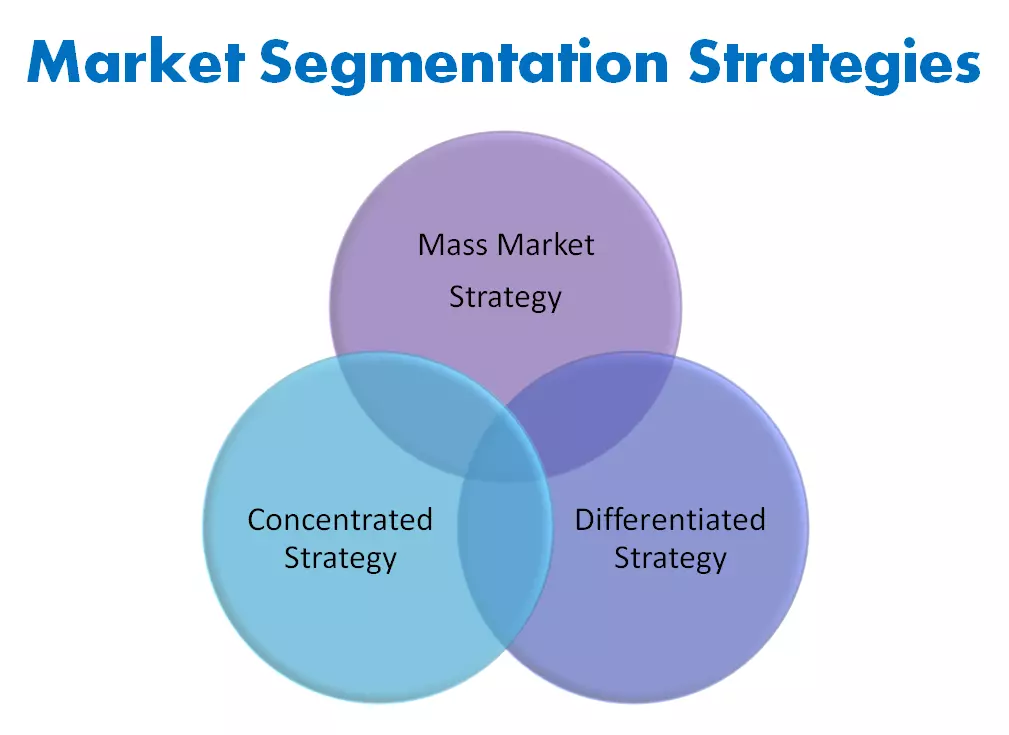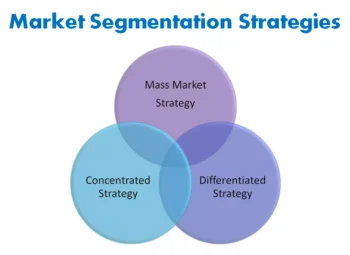Table of Contents:-
- Process of Market Segmentation
- Market Segmentation Strategies
Process of Market Segmentation
The process of market segmentation involves dividing a large target market into smaller sections, more defined segments based on particular criteria.
It is an accepted view that the market segmentation process consists primarily of three stages:
1) Determining Demand Pattern/Survey Stage
Demand patterns indicate the uniformity or diversity of consumer needs and desires for certain categories of goods and services. A company would face one of three demand patterns.
i) Homogeneous Preferences
Homogeneous preferences show a market where all the customers have roughly the same choices. The market shows no natural segments. One would predict that existing brands would be similar and cluster around the middle of the scale in both saltiness & sweetness.
ii) Diffused Preferences
At the other extreme, consumer preferences may be scattered throughout the space, indicating that customers differ wildly in their preferences. The first brand to enter the market is likely to position itself in the centre to appeal to the most people.
iii) Clustered Preferences
The market may reveal different preference clusters, referred to as natural market segments. The first company in this market has three options. It might position itself in the centre, aiming to appeal to all the groups. Alternatively, it could focus on the largest market segment (concentrated marketing). Another option is to develop several brands, each positioned in a different segment. If the first company develops only one brand, competitors could enter the market and introduce new brands in the other segments.
In addition to this, the survey stage is divided into two parts, viz.
i) Focus group discussions and in-depth interviews to get an insight into consumer motivation, attitude and behaviour.
ii) On this insight develop a questionnaire which is administered to a sample group of consumers.
The purpose of this questionnaire is to collect data on the following points:
a) Attributes sought in a product & their priority ratings,
b) Brand awareness and rating of various brands,
c) Product usage patterns,
d) Customer attitude towards the generic product or product category,
e) Psychographic, demographics, and media habits of sample respondents.
2) Establish Possible Bases of Segmentation/Analysis Stage
It is widely assumed in marketing that segmentation is an art, not a science. The key task is to find the variable that divides the market into actionable segments. There are two different types of segmentation variables:
- i) Needs
- ii) Profilers
The basic criteria for segmenting a market is customer needs. To find the needs of customers in a market, it is essential to undertake market research. Profilers are the descriptive, measurable customer characteristics (such as age, location, gender, nationality and income) that can be used to inform a segmentation exercise.
After collecting the data, it is examined using factor analysis. This is used to identify factors that different customer groups. Cluster analysis is used to cluster customers into maximally various groups.
3) Identify Potential Market Segments/Profiling Stage
In this stage, each cluster is profiled in terms of psychographics, demographics, attitudes, media habits, behaviour, and consumption habits. The marketer can give each segment a name based on dominant distinguishing characteristics.
After performing customer segmentation, an individual can understand who the customers are from a demographic perspective. An accurate profile of the customers allows one to analyse market areas or neighbourhoods to understand the penetration rates and the market potential for products and services. Penetration rate points to where the market opportunity exists.
By identifying and understanding the customers in the clusters one has the highest penetration, one can target marketing or business activities to those who are most likely to buy the products. One can improve response rates and ROI by precisely marketing to prospects with offers that appeal particularly to them.
Customer profiling is a key analysis required to project the size of the total market opportunity, and project revenue and customers for new or planned locations. Few companies can make successful site selection decisions without understanding customer profiles.
Market Segmentation Strategies
Essential to any segmentation strategy are decisions defining how many market segments will be encompassed by the firm’s marketing program and how boundaries for these segments will be established. At one extreme, the marketer might elect to consider all actual or prospective customers as comprising a single market and design a single offering to satisfy needs in this single market.
At the other extreme, the marketing manager might consider each customer a unique, discrete market in itself, and devise distinctive offerings to appeal to each. An example of this is large aeroplane manufacturers (Lockheed, Boeing) serving a relatively small number of large airlines (Lufthansa, United, Qantas).
Along this spectrum from total to individual target market segments, three segmentation strategies can be identified:
- Mass-Market Strategy
- Differentiated Strategy
- Concentrated Strategy
Related Articles:
- nature of marketing
- difference between questionnaire and schedule
- features of marginal costing
- placement in hrm
- limitations of marginal costing
- nature of leadership
- difference between advertising and personal selling

1) Mass-Market Strategy
A mass-market strategy calls on a company to develop one product-service mix that is marketed to all potential consumers in the target markets. This approach considers the market to be a homogeneous market segment with similar wants and needs. There is no reason to develop more than one marketing program since consumers are alike and react similarly to the components of the marketing program.
For example, when McDonald’s first opened, the company offered a very limited menu that was consistent across the entire organisation. It featured only a couple of hamburger choices, soft drinks, milkshakes and french fries. No other choices were available, and all stores offered identical menus. This strategy was also used by hotel chains (e.g., Holiday Inn), airlines (e.g., United Airlines), and tourism destinations e.g., cities and countries) in the early stages of their life cycles.
2) Differentiated Strategy
When a company elects to follow a differentiated strategy, it is following a strategy that calls for the company to appeal to more than one market segment with a separate marketing program for each segment. The overall objective of this approach is to increase sales and market share by capturing sales from different smaller market segments. Each of the marketing programs, including the die product-service mix, is tailored to the specific needs of a market segment.
Most successful firms use some type of differentiated marketing strategy. Although the marketing costs associated with a differentiated strategy target market and cost, the return on investment is also Targeting the needs and wants of specific target markets and communicating directly to these target markets with separate marketing programs means that overall sales usually increase.
3) Concentrated Strategy
A concentrated, or focused, strategy calls on firms to develop modifications of one or more product-service mixes that are marketed to one or relatively few market segments with limited changes in the marketing program. This strategy can be used successfully by smaller firms that do not have the resources to compete in a broader market.
Using a concentrated strategy (also called niche marketing), Merton would focus its efforts on profitably satisfying one market segment such as the accountant market. This strategy appeals to firms that offer highly specialised goods and services and lack the resources to adopt undifferentiated or differentiated strategies. Risks implicit in this strategy derive from the company’s ties to a single segment, which might lose purchasing power or succumb to competitive appeals.
You May Also Like:-
